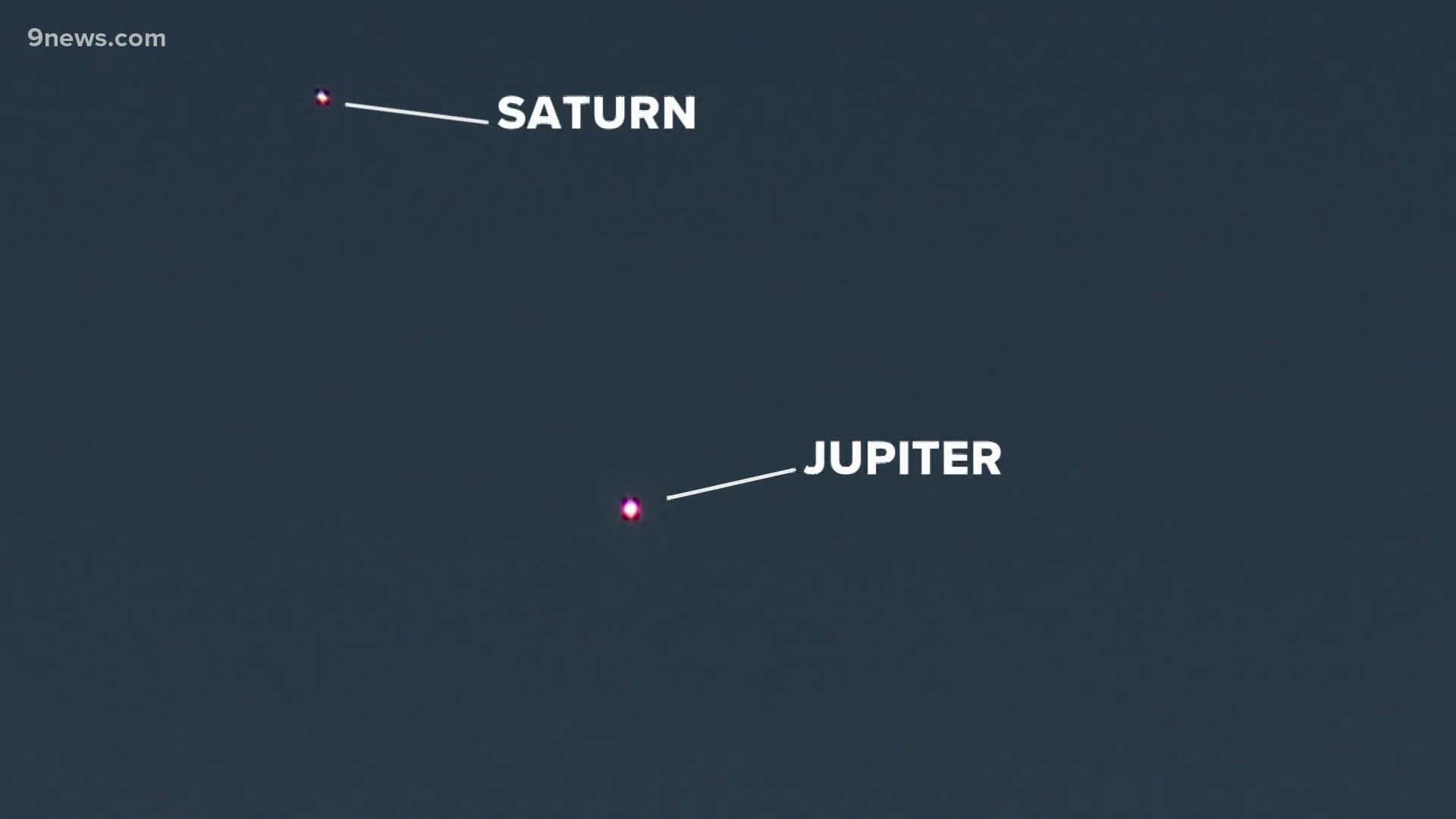COLORADO, USA — You could say we’ve been waiting for this night for nearly 800 years.
The conjunction of Jupiter and Saturn has not been seen on earth since the year 1226, and it will be visible Monday night all over North America.
A conjunction is simply when two or more objects in our sky move close to each other. It could involve planets, moons or comets moving close to each other or other stationary objects like stars. Since Jupiter and Saturn are our solar system's two biggest planets, this one is called The "Great" Conjunction (some are calling it the "Christmas Star").
The weather forecast is favorable for viewing this rare spectacle for almost all of Colorado, including the Front Range. A mountain wave cloud has developed just east of the Rockies on Monday morning, but that is expected to dissipate around sunset.
If it does remain, you won’t have to go far to escape it’s obstruction. Otherwise some scattered cumulus could develop due the warm temperatures, but most of us will have a great view.
When to watch
So the time to watch will be just after sunset Monday. The sun goes down at 4:40 p.m. and the last light is at 5 p.m. The great conjunction of planets will start to become visible sometime just after 5 p.m., but will be very faint at first. By 5:15-5:20 p.m., you should have vivid scene.
How to find it
To find the conjunction, start by facing due west, then turn slightly to the southwest and start looking up. Saturn and Jupiter will be about 20-30 degrees above the horizon, 90 degrees being straight up.
It will be a little more difficult to see Monday night because to the naked eye, the planets will appear to be just one bright object. It will look like a star, but it is the reflection of the sun's light bouncing off Jupiter and Saturn.
That is the Great Conjunction of 2020. It is actually already happening in the sky above our heads but we can’t see it in during the light of day. And since the objects are setting to our southwest, that means our time to witness this event is limited, especially if you live on the Front Range close to the mountains, because it will set behind the mountains long before it sets on the horizon. We’ll have roughly between 1-2 hours to see it on the Front Range, so get out there as soon as the sun goes down.
If you live on the eastern plains or the western slope where you can see the absolute southwestern horizon, or you can get on a mountain top, you will have a few extra hours to watch the conjunction.
What you'll see
To the naked eye, it will appear as just one bright object unless you have really good eyesight. If you can zoom in through a telescope, a pair of binoculars or a camera lens, then you will be able to see the slight separation of the planets. The distance is still nearly 500 million miles.
You will also be able to see the rings of Saturn and three of Jupiter’s moons — Callisto, the volcanic moon Io and Europa, which is the next target for space exploration trying to locate extraterrestrial water.
How to photograph the Great Conjunction with a DSLR
Photographing this rare event can be done in several ways with different equipment.
If you have a DSLR camera — either professional or prosumer grade — you can get some amazing photos. I would recommend using at least a 200mm lens, but the longer the better. (It's 550 million miles from earth to Jupiter and another 456 million miles from Jupiter to Saturn.)
Set your camera to an ISO of at least 1600. If you have a better camera, you can go even higher without getting a grainy image. Use an exposure of about 1 second with ISO 1600. (You don’t want to have the aperture open for much longer than that because the earth is spinning and the planets are moving.)
A tripod will eliminate blurring, and if you can use a bigger ISO, you can use a shorter exposure, which will even further eliminate blurring.
How to photograph the Great Conjunction with a smart phone
If you don’t have a DSLR available, you can use your smart phone. Again, the better the phone, the better the image.
Try to use a small phone tripod or somehow rig it to be completely steady. Then set the conjunction in the center of the targeting square and set your focus and iris to manual. On most phones that can be accomplished by holding your finger on the screen for a couple seconds.
Lastly, once the image is centered with auto focus and auto iris disabled, you will need to use the timer function to actually take the image. If you use your finger, the little vibration of the phone will blur the image.
Another thing you can try if you have a telescope or binioculars is putting your camera lens up to the lens of the instrument and effectively take a picture of what your instrument is displaying.
Other viewing
Unfortunately, with the COVID-19 pandemic, all events planned at the local planetariums and museums have been canceled. You can, however, watch a live stream from National Aeronautics and Space Administration (NASA) at: nasa.gov/nasalive
SUGGESTED VIDEOS: Colorado Guide

